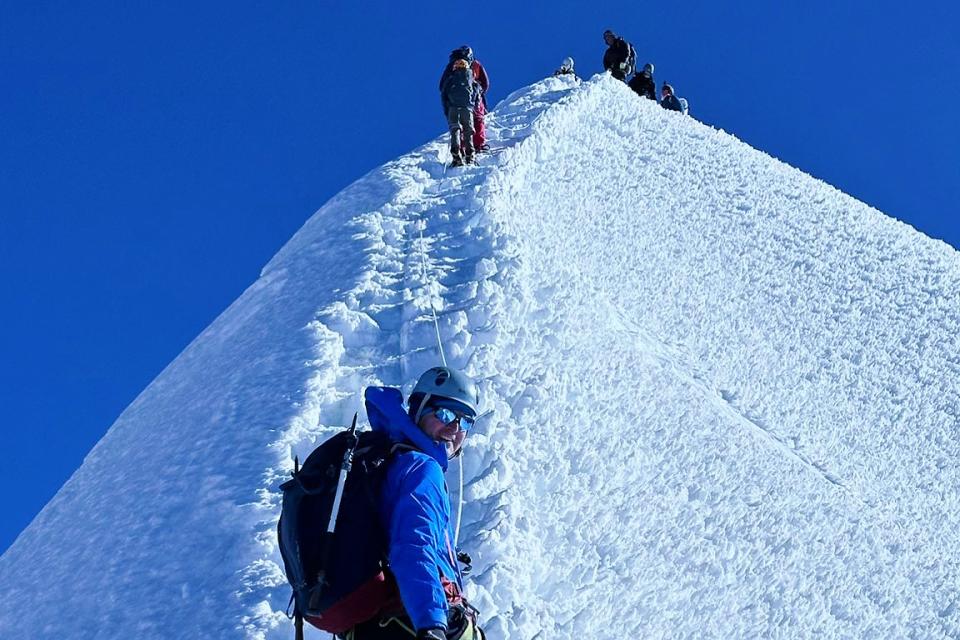Overview
Island Peak also known as Imja Tse is one of the most popular Himalayan Mountains. It is known for its appearance as an island drifting on a sea of ice. It serves both beginner climbers and experienced climbers. Island Peak is known as an alternative for Everest who is willing to learn the art of mountain climbing. The summit, though physically demanding, is not technically challenging. It offers one of the easiest and safest climbing experiences in the Himalayas. Island Peak Climbing from Chhukung fulfills more than enough for those having time restrictions. The summit stands adjacent to the world's largest ice walls offering stunning views of its neighboring Himalayan Mountains that dominate the skyline. The panoramic views of Nuptse, Lhotse, Cho Oyu, Makalu, Ama Dablam, and Baruntse can be viewed in their full glory.
Island Peak Climbing from Chhukung is a famous trekking peak in the Khumbu region of Nepal. Standing at an elevation of 6,189 meters (20,305 feet), it offers an exhilarating challenge for climbers seeking to climb the Himalayas. The journey to Island Peak typically starts from Chhukung, a beautiful village nestled in the heart of the Everest region.
Island Peak climb starting at Chhukung is more than just a climb; it's an adventure that combines the thrill of mountaineering with the rich cultural experience of trekking through the Everest region. This expedition takes you through stunning landscapes, and quaint Sherpa villages, that offer breathtaking views of some of the highest peaks in the world, including Mount Everest, Lhotse, and Ama Dablam.
Island peak climbing from Chhukung distance is about 6 km and usually takes 3 days to complete the journey.
This comprehensive guide is designed to provide you with all the essential information you need before ascending the Island Peak climbing expedition from Chhukung. From detailed route descriptions and difficulty assessments to Island Peak climb cost breakdowns and packing lists, we cover every aspect of the adventure. Whether you're an experienced climber or a sincere trekker looking to take on a new challenge, this guide will help you prepare for a safe and successful ascent. Island peak climbing for 3 days from Chhukung is worth undertaking.
Highlights of Island Peak Climbing from Chhukung
Climbing Island Peak from Chhukung is an extraordinary experience filled with breathtaking scenery and challenging adventures. Here are some of the highlights:
The Island Peak expedition starting in Chhukung is an extraordinary trip among glorious mountains all around. You can get a break from everyday life and relax in the arms of nature.
- Beautiful Views: Enjoy panoramic views of towering peaks like Lhotse, Nuptse, and Ama Dablam.
- Cultural Experience: Immerse yourself in the Sherpa culture, visiting monasteries and experiencing local hospitality.
- Experience: The climb offers a mix of trekking, scrambling, and glacier travel, making it an exciting challenge for mountaineers.
- Achievement: Standing on the summit at 6,189 meters (20,305 feet) is a reward.
Route Details for Island Peak Climbing from Chhukung
The journey to the summit of Island Peak from Chhukung follows a well-defined route. Here’s an overview:
- Chhukung to Island Peak Base Camp: The trek starts with a hike from Chhukung to the Island Peak Base Camp, located at 5,100 meters (16,728 feet). This 5-kilometer (3.1-mile) trek takes about 3 to 4 hours.
- Base Camp to High Camp: From the base camp, climbers often move to a high camp at around 5,600 meters (18,372 feet) to shorten the summit day.
- Summit Day: The final ascent involves climbing a steep headwall and negotiating a ridge to reach the summit. After enjoying the summit views, climbers descend back to base camp and return to Chhukung.
Is Island Peak Summit via Chhukung Dangerous?
Climbing Island Peak is an adventurous journey that comes with countless risks. Island Peak climb beginning at Chhukung can be challenging for beginners. It requires proper training and dedication to succeed in the ascent. However, with proper preparation and caution, these risks of Climbing Island Peak from Chhukung can be managed effectively.
- Altitude Sickness: The high altitude can cause acute mountain sickness (AMS). It's crucial to acclimatize properly and be aware of the symptoms.
- Weather Conditions: The weather in the Himalayas can be unpredictable. Climbers must be prepared for sudden changes and carry appropriate gear.
- Technical Challenges: The climb involves technical sections, including a steep headwall and a narrow summit elevation. Basic mountaineering skills and the use of crampons and ice axes are essential.
- Glacial trials: The route traverses glaciers with hidden trials. Roping up and following safe glacier travel practices are mandatory.
Is the Island Peak climbing route from Chhukung Hard to Climb?
Island Peak presents significant challenges that require physical fitness and technical skills. Here’s an assessment of its difficulty:
- Physical Fitness: Climbers need to be in excellent physical condition, as the ascent involves long days of trekking and climbing.
- Technical Skills: Basic mountaineering skills, such as crampons, ice axes, and ropes, are necessary. Prior experience with climbing can be a benefit.
- Acclimatization: Proper acclimatization is crucial to avoid altitude sickness. Spending time at higher altitudes before the climb helps climbers adjust to the reduced oxygen levels.
- Mental Toughness: The climb can be mentally demanding. Determination and a positive mindset are essential to overcome challenges.
Understanding the Climbing Difficulty of Island Peak from Chhukung
Climb Island Peak from Chhukung to experience the rewarding endeavor. Here’s a detailed look at the various aspects that contribute to its difficulty:
- Height Gain: The climb involves significant elevation gain, from Chhukung at 4,730 meters (15,515 feet) to the summit at 6,189 meters (20,305 feet).
- Landscape: The route includes trekking through rocky trails, running on mixed terrain, and navigating glacier sections.
- Specialized Sections: The final ascent features a steep headwall and a narrow ridge. Proficiency in using climbing equipment such as ropes, crampons, and ice axes is crucial.
- Climate Conditions: Harsh weather, including strong winds and low temperatures, can add to the difficulty. Climbers must be prepared for varying conditions.
- Physical and Mental Stamina: Endurance is key, as the summit day can take 11 to 12 hours round-trip. Mental fortitude is equally important to stay focused and motivated.
Permits Required for Island Peak Climbing from Chhukung
Securing the necessary permits is a crucial step for the Island Peak adventure from Chhukung. Here’s what you need:
- Climbing Permit: Issued by the Nepal Mountaineering Association (NMA), this permit is mandatory for all climbers.
- Sagarmatha National Park Entry Permit: Required to enter the national park, where Island Peak is located.
- Khumbu Pasang Lhamu Rural Municipality Permit: Another essential permit for trekkers and climbers in the region.
To obtain these permits, you can apply through a trekking agency or the NMA office in Kathmandu. It’s advisable to arrange permits well in advance to avoid any last-minute issues.
Best Time for Island Peak Climbing from Chhukung
Choosing the right time is critical for a successful expedition to Climb Island Peak via Chhukung. Here are the best seasons:
- Spring (April to May): Offers stable weather, clear skies, and moderate temperatures. This is a popular time for climbing with lush landscapes.
- Autumn (September to November): Known for its stable weather, clear views, and pleasant temperatures. Post-monsoon season provides pristine conditions.
- Monsoon (June to August): Generally not recommended due to heavy rainfall, slippery trails, and the risk of landslides.
- Winter (December to February): Possible but challenging due to extremely cold temperatures, heavy snowfall, and harsher conditions.
Planning your climb during spring or autumn maximizes your chances of favorable weather and a successful summit.
Island Peak Climbing from Chhukung Cost For 2024 and 2025
Understanding the Island peak cost helps in budgeting and planning your trip. The cost for an island peak climb is comparatively more than that of a Mera peak climbing cost due to its tough trail. Here’s a breakdown of the expenses for the Climbing Island Peak Expedition from Chhukung:
Island Peak climbing from Chhukung price usually includes these factors.
- Permit Fees: Climbing permits, national park entry, and municipality permits.
- Guide and Porter Fees: Hiring a guide and porter is essential for safety and convenience. Expect to pay $25-$30 per day for a guide and $15-$20 per day for a porter.
- Accommodation and Food: Lodging in teahouses and meals can range from $25 to $50 per day. Higher elevations might be more expensive.
- Equipment Rental: Renting gear like crampons, ice axes, and harnesses.
- Travel Insurance: Comprehensive insurance that covers high-altitude climbing is crucial.
- Other expenses include transportation, tips, and personal expenses.
The total cost for Island Peak climbing from Chhukung typically ranges from $ 800 to $999 per person, depending on the services and duration.
Island Peak climbing from Chhukung price for Nepali citizen eagles from NPR 60000 to 80000
Outline Itinerary:
Day 1: Arrive in Chhukung
Day 2: Hiking from Chhukung to Island Peak Base Camp
Day 3: Climb to Island Peak Summit and Return
Food and Accommodations for Island Peak Climbing from Chhukung
Proper nutrition and comfortable lodging are essential for a successful climb. Here’s what to expect:
- Teahouses: Along the route, you’ll find teahouses that offer basic but comfortable accommodations. Rooms are usually twin-sharing with common bathrooms.
- Meals: Teahouses provide a variety of meals, including traditional Nepali dishes like dal Bhat (lentil soup with rice) and international options like pasta, noodles, and pancakes.
- Water: Safe drinking water is crucial. Bottled water is available, but using water purification tablets or a filter can be more economical and environmentally friendly.
- Snacks: Carrying high-energy snacks like nuts, energy bars, and chocolates is advisable for quick boosts of energy during the climb.
Conclusion and Tips
As you conclude your Island Peak climbing journey from Chhukung, here are some essential tips to ensure a successful and enjoyable experience:
- Training: Prepare physically and mentally for the climb. Engage in regular cardio, strength training, and practice with climbing gear.
- Acclimatization: Take your time to acclimatize properly to avoid altitude sickness. Follow the “climb high, sleep low” principle.
- Hydration and Nutrition: Stay hydrated and eat a balanced diet. Carry high-energy snacks to maintain energy levels.
- Weather Awareness: Keep an eye on weather forecasts and be prepared for sudden changes. Carry appropriate clothing and gear.
- Safety First: Always prioritize safety. Follow your guide’s instructions, use the right equipment, and don’t push beyond your limits.
Island Peak climbing itinerary from Chhukung
Day 1: Arrive in Chhukung
Your adventure begins with your arrival in Chhukung, a quaint village situated at 4,730 meters (15,515 feet). Here’s what you can expect on the first day:
- Travel to Chhukung: Most climbers reach Chhukung by trekking from Dingboche, a journey that takes about 2 to 3 hours.
- Acclimatization: Spend the day acclimatizing to the altitude. It’s important to take it easy and let your body adjust.
- Exploration: Explore the village, visit local teahouses, and enjoy the stunning views of the surrounding peaks.
- Preparation: Use this time to prepare your gear and finalize plans with your guide for the upcoming days.
Day 2: Hiking from Chhukung to Island Peak Base Camp
On the second day, you’ll hike to Island Peak Base Camp. This day is going to be a remarkable one on your journey. Today, you will be climbing the Island Peak base camp from chhukung. Here are the details:
- Distance and Duration: The hike covers 5 kilometers (3.1 miles) and takes about 3 to 4 hours.
- Route: The trail ascends gradually, offering beautiful views of the Imja Valley and surrounding peaks.
- Base Camp: Located at 5,100 meters (16,728 feet), the base camp is a temporary settlement with tents set up for climbers. Here, you’ll rest and prepare for the summit push.
- Acclimatization: Spend the rest of the day acclimatizing and going through a final gear check.
Day 3: Climb to Island Peak Summit and Return
Climbing to Island Peak Summit and Returning to Chhukung
Summit day is the most challenging and rewarding part of the expedition. Today you will climb up to the island peak from Chhukung. After spending quality time, we descend back to the Base Camp following the same path. At the summit during the Island Peak Climbing Trip from Chhukung, we reward ourselves with the glorious view that surrounds us. Here’s a detailed itinerary:
- Early Start: Begin the climb around 4 AM to reach the summit before noon.
- Route: The initial part involves trekking on a rocky trail, followed by climbing the glacier. The final section includes a steep headwall and a narrow ridge.
- Summit: Reach the summit of Island Peak (6,189 meters | 20,305 feet). Enjoy breathtaking views of Everest, Lhotse, and other Himalayan giants.
- Descent: After spending some time on the summit, descend back to base camp and then to Chhukung. The entire round trip takes about 11 to 12 hours.
What is included?
- Island Peak Climbing Permit.
- Experienced English Speaking Climbing Sherpa Guide.
- 1 breakfast, 1 lunch, and 1 dinner with tea and coffee
- All climbing equipment - Ropes, Ice Axe, Harness, Carbine, Ice Screws, Crampons, Boots etc.
What is not included?
- Hotel in Kathmandu (we can assist you if required).
- Everest National Park Entry Permit and Trekkers Information Management System (TIMS) fee (we can assist you if required).
- Flight Kathmandu - Lukla - Kathmandu (we can assist you if required).
There are a number of things that you need to keep in mind if you ever plan for your vacation. Because you want to make the most out of your limited time, it is truly a hectic job for you to find a trustworthy and experienced traveling companion. With Nepal Climbing, you have your problem solved already as we are one of the leading Trekking and Mountaineering organizations in Nepal and have been providing first class service in several travelling packages across the country for many years.
We prioritize your satisfaction and safety
At Nepal Climbing Adventure, our ultimate objective is to arrange the programs for you to make the most out of your valuable time. We value your satisfaction, adventure, amusement and safety. Regardless of whether you are searching for stunning perspectives along the trekking trails in Himalayan mountain range or widely acclaimed, heavenly attractions with developed societies, our exposure and experience in travel business will help you ensure your requirements are met.
We have professional staffs and service
We trust that extraordinary staff lead awesome administration. That is the reason we are collaborated with experienced and eager individuals. We possess authorized and government certified guides who are very much furnished with broad learning of Nepali communities and traditions. They additionally have familiar English speaking abilities and hierarchical capacities to encourage all types trekking groups.
Responsible Tourism and social values
We are endeavoring to lessen the effect of tourism by guaranteeing our staff are very much aware of ecological issues. We are doing our best to create less waste as could be expected under the circumstances and make a point to reclaim non-compostable wastes. We outline our itineraries and work in the field guided by the standards of ecotourism and reasonable tourism. Moreover, all our staff have been given ecological preparing and are extremely aware to the eco-system we enter. Additionally, we are adhering to sustainable assets of energy. Our guides will share you the social values, culture and religious harmony for better understanding the groups you visit.
Customizable Service
Our promise is to provide you with the travelling packages customizable according to your demand fulfilling your budget criteria. So, we can facilitate a minimum of 2 individuals with a personalized service at a reasonable cost.
Online Payment
Or
WIRE TRANSFER
Bank Details:
Account Holder's Name: Nepal Climbing Adventure Pvt. Ltd.
Bank Name: Himalayan Bank Ltd.
Account Number: 01907449340018
Account Type: USD
Address: Thamel, Kathmandu, Nepal
SWIFT CODE: HIMANPKA
For more detail contact us:
Krishna Subedi (Chris Chhetri): +977 9851076791 (24/7, Call/Viber/Watsapp)
We recommend our guests have a valid insurance policy before undertaking an adventure in Nepal Himalaya. During treks and expeditions, the insurance should cover for expenses such as air ambulance, helicopter rescue, and medical care. As an adventure operator, we (NCA), are not permitted to arrange or sell insurance packages here in Nepal as per the Government of Nepal.
Packing List for Island Peak ascent from Chhukung
Essential Packing List for Island Peak Climbing from Chhukung consists of the right gear to ensure safety and comfort during your climb. Here’s a comprehensive packing list:
Clothing:
- Base layers (thermal tops and bottoms)
- Insulating layers (fleece or down jacket)
- Outer shell (waterproof and windproof jacket and pants)
- Trekking pants and shorts
- T-shirts (moisture-wicking)
- Warm hat and sun hat
- Gloves (inner and outer)
Footwear:
- Sturdy trekking boots
- Gaiters
- Trekking socks (multiple pairs)
Climbing Gear:
- Crampons
- IceAxe
- Climbing harness
- Helmet
- Carabiners and ascenders
- Rope (if not provided by the guide)
Other Essentials:
- Sleeping bag (rated for -20°C/-4°F)
- Trekking poles
- Sunglasses (UV protection)
- Headlamp with extra batteries
- Water bottles or hydration system
- Water purification tablets
- Personal first aid kit
- Sunscreen and lip balm
- Snacks and energy bars
Documents:
- Passport and copies
- Permits
- Insurance details
Frequently Asked Questions (FAQs)
1. Is Island Peak Climbing from Chhukung easy to climb?
Yes! Island peak from Chukkung is achievable if you have good physical condition and some sort of prior experience. As per record even 50-60 years old have achieved the summit.
2. How much does climbing the Island Peak from Chhukung cost?
Climbing the Island Peak from Chhukung costs around $900. This cost includes the itinerary route and 3-time food with an experienced guide.
3. Do I need a climbing permit for Island Peak Climbing from Chhukung?
Yes, you need a permit for Climbing Island Peak from Chhukung. The necessary permits include:
- Island Peak Climbing Permit
- Sagarmatha National Park Entry Permit
- Khumbu Pasang Lhamu Rural Municipality Entrance Permit
4. What grade is Island Peak from Chhukung?
The difficulty of Island Peak has been classified as '2B'. Despite being one of the recommended practice peaks for beginners, it still requires mountaineering tools and cannot be scaled solely as a trekking peak.
5. Which is harder, Mera Peak or Island Peak?
Mera peak is harder than that of Island Peak as per the technicality and the ascent. An island peak is for the practice of adapting to peak climbing. Mera Peak on the other hand required the technicality and prior experience for the ascent.
6. What is the hardest climbing level?
As of July 2024, the most difficult single-pitch redpoint for men was at the grade of 9c (5.15d), while for women it was 9b (5.15b). The most challenging onsight for men was at the grade of 9a+ (5.15a), and for women it was 8c (5.14b). The toughest boulder problem solved by men was at the boulder grade of V17 (9A), and for women it was V15/V16 (8C/8C+).
7. How difficult is Island Peak Climbing from Chhukung?
Island Peak Climbing from Chhukung is considered a moderately challenging climb. The climb is classified as PD+ (Peu Difficile Plus, or slightly difficult) on the IFAS. It involves crossing crevasses, using fixed ropes, and ascending steep sections of ice and snow. While it does not require advanced technical climbing skills, climbers should have good physical fitness, some experience with high-altitude trekking, and basic mountaineering skills, such as using crampons, ice axes, and ropes.
8. What is the best season to climb Island Peak from Chhukung?
The best seasons to climb Island Peak from Chhukung are:
- Spring (April to May): This season offers stable weather, clear skies, and moderate temperatures, making it ideal for climbing. The spring season also features blooming rhododendrons, adding beauty to the trek.
- Autumn (October to November): Another excellent season for climbing, autumn provides stable weather, clear views, and fewer chances of precipitation. The post-monsoon period ensures that the trails and peaks are in good condition for climbing.
9. What is the easiest climb in the world?
Cho-Oyu is known for its gradual slopes and well-defined routes, making it the easiest mountain to climb at 8000 meters. Its accessibility from both Nepal and Tibet allows climbers with different skill levels to conquer it.
10. How long does it take to climb Island Peak from Chhukung?
It takes 3 days to climb Island peak from Chhukung. The itinerary goes like :
- First Day: Arrive in Chhukung
- Second Day: Hiking from Chhukung to Island Peak Base Camp
- Last day: Climb to Island Peak Summit and Return





















 Chris Chhetri
Chris Chhetri